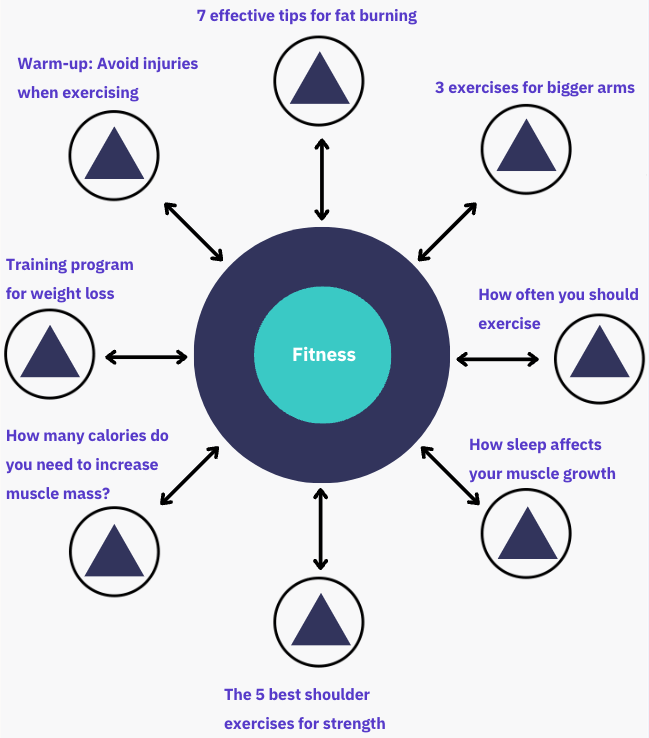Topic clusters – or content clusters – are a content strategy in SEO that builds your website’s authority (also called topical authority).
A topic cluster is, in short, a group or cluster of content on separate landing pages that deals with and covers different branches of the same topic.
For many, the concept of topic clusters is diffuse and not very tangible. In this post, I’ll cover the topic, give you a clear understanding of what it is and how to create topic clusters that pave your way to the top of the search results.
If SEO is a new area for you, you can also read our SEO guide for beginners here.
What is topic clusters?
Topic clusters are an SEO strategy that helps organize and structure your website content to improve search engine visibility. This strategy gathers related topics around a central “pillar page”, which acts as the main point for a broad topic. This page links to and from smaller, more specific “supporting pages” or “cluster pages”.
The whole basis of creating topic clusters is to cover a topic broadly and deeply enough that all information can be found on your website. This is both for the sake of the user and for Google.
In 2013, Google released an update to their algorithm called “Hummingbird”, which created a breeding ground for topic clusters. More on that algorithm update later.
A topic cluster consists of three main elements:
- Pillar Page: An in-depth page that covers a broad topic. It serves as the main page of your cluster and provides a comprehensive overview.
- Supporting pages: These pages focus on specific sub-topics and questions related to the pillar page. Each page delves into a specific aspect of the main topic and answers specific questions.
- Internal linking: Effective internal links between the pillar page and cluster pages are crucial. These links help search engines understand the relationship between the pages and strengthen your site’s authority on the topic.

When Google looks at your website, they don’t just evaluate individual pages, but also how the content is related and how far you stray from the overall topic of the domain.
By using topic clusters, you can create a stronger topical authority. Google perceives this structure as a sign that your website is an authoritative source within a specific topic area. This happens because:
- Related content: Google can see that you have extensive coverage of a topic through both your pillar page and your supporting pages. This shows that you have in-depth knowledge and expertise in the area.
- Internal linking: The internal links between your pages help Google understand the structure and context of your content. This makes it easier for Google to crawl and index your pages and can improve your ranking in search results.
- User experience: A well-organized website with clear internal links and structured content improves user experience. When users find what they’re looking for and engage more with your content, it sends positive signals to Google about the quality and relevance of your site.
By implementing topic clusters, you can not only improve your organization and visibility, but also strengthen your topical authority in Google’s eyes, which can lead to higher rankings and more organic traffic.
User behavior on your website is important because Google uses user signals, including Chrome data, to assess whether a user finds your content good and relevant.
Google operates with “Long Clicks” and “Short Clicks” which basically just means that users who click into your site via the search results either stay on your site for a long time and click around, which is a positive signal to Google that you provide quality content – or spend a short time on the site and click back to the search results, which signals to Google that your result did not meet the user’s expectations or search intent.
What is topical authority?
Topical authority is a website or domain’s “expertise and credibility” within a specific topic and/or niche explained in one term.
Topical authority is not a “public” metric that you can look at and put two lines under that you have a given authority. It works for Google in the same way as “experts” in real life that you see on TV.
It’s a measure of how comprehensive and in-depth your content is on a particular topic and how the content is structured and related. In the context of topic clusters, the concept becomes even more relevant and effective.
When you use topic clusters, you build your topical authority in the following ways:
- Comprehensive coverage of the topic: By creating a pillar page that provides a broad and in-depth overview of a topic and linking to cluster pages that go into detail on specific aspects of the topic, you show that you have a thorough understanding of the subject. This comprehensive network of content signals to Google that your site is a reliable source of information on the topic.
- Structured content: Topic clusters organize your content in a logical and user-friendly way. When Google sees that your content is well-structured and easy to navigate, it considers your website to be an authority on the topic. Internal links between pillar page and cluster pages help Google understand the context and depth of your content.
- Relevance and depth: By covering both broad and specific keywords related to a topic, you show Google that your website is relevant to many aspects of the topic. This relevance and depth is key to building topical authority as it demonstrates your ability to provide valuable and comprehensive information.
- User signals: A well-structured website where users can easily find related information through internal links improves user experience. When users engage more with your content and spend longer on your site, it sends positive signals to Google about the quality and relevance of your site.
Ultimately, building topical authority through the use of topic clusters helps boost your visibility and ranking in search results. By demonstrating expertise and credibility in a specific topic area, you can attract more organic traffic and achieve higher rankings in Google search results.
How to make topic clusters
Achieve topical authority with content clusters and become an expert in Google’s eyes. Having topical authority means that you have achieved high visibility and have become an authority on a topic or niche. In SEO, the goal is to use content clusters to increase your domain’s authority to achieve better rankings.
Before you “really” get started, you need to do a brainstorm and subsequent keyword analysis to determine the most relevant topics for your website and to find the keywords to create dedicated landing pages for.
Of course, you need to find the topics where you and your company are experts. If you happen to be the owner or SEO manager of HiFi Klubben, it could make sense to build clusters around the main topics “speakers” and “headphones” with all the small but important sub-topics that go with them.
See the steps you need to go through to build topic clusters here:
- Plan your cluster: Select your pillar page + supporting pages: It’s crucial to plan what topics your topic clusters will cover before you start writing the content. This doesn’t necessarily mean that your plan is fully developed yet.
- Search your cluster keywords on Google and see what people are looking for: Determine what content your pillar page + supporting pages should contain by first researching what users are searching for that relates to your topic and what information they are looking for. You do this by searching your supporting pages keywords, clicking on results #1-5 and seeing what content they have and creating something similar – but better.
- Write a thorough pillar page – the most important page: Your cluster’s pillar page is the foundation and central focus area. Choose a topic that is broad enough to accommodate multiple subtopics, but avoid making it too general. “Marketing” is too broad, but search engine optimization is precise and includes subtopics like link building and texts. The pillar page is the key element of your cluster, in-depth and the longest content. Always build your pillar page first and then build your supporting pages afterwards to support the main page.
- Build smaller supporting pages using the keywords for the subtopics: Create pages targeting more specific subtopics within your main topic. These pages are secondary and should cover topics that are big enough to stand alone, but still be a sub-topic of your pillar page. Find out what questions users are asking or just topics that relate to the main topic. Read on to see an example of what a cluster might look like.
- Connect the pillar page and supporting pages with internal links: The key to completing your cluster is to link all your pages together with internal links. Link between the pillar page and supporting pages on the keyword the pages have in common. Always link to your pillar page – if your cluster is large, it’s likely that you can’t link to all supporting pages from your pillar page.
- Revise and update your content regularly: Update outdated content regularly or expand with more supporting pages.
How many pages are in a cluster?
The number of pages in a topic cluster can vary depending on the scope and demand of the topic, but an effective topic cluster typically consists of a pillar page and several cluster pages that together cover the topic thoroughly and in depth. Here are some guidelines for determining the number of pages in a topic cluster:
- Pillar page: There is always one pillar page that acts as the central hub for the broad topic. This page should provide a comprehensive overview and be the primary starting point for the related cluster pages.
- Supporting pages: The number of cluster pages can vary, but it is common to have between 5 and 20 cluster pages for a single topic cluster. This depends on how many relevant subtopics and keywords you want to cover. Each page should focus on a specific aspect of the main topic and provide in-depth information.
- Topic coverage: To ensure strong topical authority, your supporting pages should collectively cover all important aspects of the main topic. It’s important that you have enough supporting pages to answer the most relevant and searched questions within the topic.
- Quality over quantity: It’s better to have fewer but more comprehensive and well-researched cluster pages than many pages with superficial content. Make sure each cluster page provides real and useful value and is optimized for search engines.
- Flexibility and scaling: Be flexible and ready to add more cluster pages as your topic evolves or new relevant subtopics emerge. Topic clusters are dynamic and can be scaled up to include more pages if needed.
A well-structured topic cluster with a solid pillar page and an appropriate number of cluster pages can significantly improve your SEO strategy. By ensuring you have enough pages to cover all relevant aspects of your topic, you can achieve higher rankings in search results and increase your website’s authority and visibility.
Your pages are initially assessed as standalone individuals, but Google assesses your overall domain and how far you stray from the topic in your domain-wide content. You will therefore experience a spillover effect, as intended, and all your pages will boost each other.
Why work with topic clusters for SEO?

There are many good reasons why you should work with topic clusters on your website. The main reason is that Google is getting better and better at understanding context and your traffic can increase radically with this strategy.
One major factor that has promoted the importance of topic clusters is the Google algorithm update from 2013 known as “Hummingbird”. This update changed the way Google understands and processes search queries by focusing more on the context and meaning behind keywords rather than just the individual words.
Hummingbird enabled Google to deliver more accurate and relevant search results by understanding entire search queries and their intent.
With the Hummingbird update, it became important to create content and have a content marketing strategy that was not only optimized for specific keywords, but also covered topics broadly and in depth. Topic clusters are a direct response to this change as they provide a structured way to show Google that your website contains comprehensive and relevant information on a given topic.
You should work with topic clusters because:
- Improve crawl and indexing: By structuring your content in topic clusters, you make it easier for search engines like Google to crawl and index your landing pages. The internal links between pillar page and cluster pages help search engines understand the context and hierarchy of your content, which can lead to better indexing.
- Increased topical authority: When you cover a topic thoroughly through a pillar page and related cluster pages, you demonstrate to search engines that your website is an authoritative source on that topic (some would use the term “trusted advisor”). The increased topical authority can improve your rankings in search results for both broad and specific keywords.
- Better user experience: An easily navigable website with clear internal links and structured content improves the user experience. When users can easily find related and relevant information and navigate between pages, they are more likely to stay on your website longer and engage more with your content. This sends positive signals to search engines about the quality and relevance of your site.
- More organic traffic: By creating content that covers all aspects of a topic, you can attract a wider audience and capture more search results. Cluster pages that focus on specific keywords and subtopics can rank high for long-tail keywords, increasing your overall organic traffic.
- Cohesive link structure: The internal links between your pillar page and cluster pages help distribute link value (link juice) across your content. This can strengthen your entire topic cluster and help individual pages rank better in search results.
- Targeted Content Strategy: By using topic clusters, you can plan and create content in a more targeted way. This ensures you cover all relevant subtopics and answer the questions your users have. A targeted content strategy is more effective and can lead to better SEO results.
Overall, implementing topic clusters can help improve your SEO strategy by increasing your website’s visibility, authority and user engagement. This can lead to higher rankings in search results and increased organic traffic, which is crucial to your website’s success.
Topic cluster example
There aren’t many limitations on what topics you can build a topic cluster around. The only limit is your imagination – and of course your products or services.
Overall, there are two things you need to be aware of before you get started: It must be relevant to your product or service and the topic must be broad enough to “carry” a number of separate landing pages on specific subtopics.
In the example below, I’ve chosen to create a small cluster around the keyword “strength training”.
To rank on “strength training”, it’s not enough to have a page targeting “strength training”. No, you need to be the expert and provide users with all the information, useful knowledge, guides, recipes, training programs etc. that relate to “strength training”.
Below you see one pillar page (strength training, turquoise circle) and 8 supporting pages with the title of the post to be made (triangle) and the internal links back and forth. You could also put arrows (internal links) between supporting pages if it makes sense to link from one supporting page to another (which it often does, but I have simplified it in the example).

For example, a main page should be created for strength training and a number of informative posts as well as training programs and exercises that are relevant and useful to the user searching for “strength training”.
In addition to providing a lot of value to the user, you’re also signaling to Google that you’re on top of the topic, care about your users and are genuine in your efforts to deliver quality content to them.
Pitfalls to avoid
When working with topic clusters as part of your SEO strategy, there are several pitfalls to be aware of and work around. Creating pages for each topic is not enough in itself.
Here are some of the pitfalls I often see:
- Lack of relevance and depth: One of the biggest mistakes is creating superficial content that doesn’t go into depth on the topic and has no real value for the user. To build strong topical authority, it’s important that both your pillar page and your cluster pages contain comprehensive and valuable information. Make sure each page answers specific questions and covers the topic thoroughly. If a user is left with doubts or questions and you don’t have another separate page that covers it, the page is not optimized enough.
- Poor internal linking: An effective topic cluster requires strong internal links between the pillar page and cluster pages. Not adding these links can confuse search engines and you won’t get the full value of your cluster. Make sure your internal links are clear and logical so both users and search engines can easily navigate your content. Add links with anchor texts that give the user and search engines a clear idea of what they can expect to be redirected to.
- Too much focus on keywords: While keywords are still important, over-optimization can hurt your SEO. Avoid overfilling your content with keywords (keyword stuffing). Instead, focus on writing natural and contextually relevant content. The whole idea of building a topic cluster is to move away from the classic SEO approach of keywords to focus on topics. Keywords are still relevant and important in 2024 because, after all, they are still what content is made up of and provide context and understanding.
- Lack of focus on user experience: A poor user experience can damage your SEO, no matter how well optimized your content is. Make sure your website is easy to navigate and that your content is easy to read and interact with. A good user experience improves engagement and sends positive signals to search engines. Google uses user signals to rank websites, so it’s important that you give users a seamless experience and provide them with all the information they are looking for.
- Outdated content: SEO is an ongoing process and it’s important to keep your content fresh and up-to-date. Outdated information can damage your credibility and ranking. Regularly review your pillar page and cluster pages to ensure they remain relevant and up-to-date. New technologies, best practices and recommendations emerge over time and the knowledge you pass on should always be up-to-date to provide users with the most current knowledge.
- Lack of internal and external link building: Besides internal links, external links are also important for SEO. Make sure to include external links to trusted sources and work on getting backlinks from authoritative sites within your niche that can increase your site’s authority and credibility.
- The E-E-A-T Principles: Google ranks content based on Experience, Expertise, Authority and Trustworthiness (E-E-A-T), among other things. Make sure your content is written by experienced experts, shows authority and is trustworthy.
That said, you should still remember to stick to the “classic” SEO rules and best practices. Working from the topic cluster strategy is just one way to work with content structure and building.
Google evaluates and ranks your landing pages on hundreds of major and minor elements and building content in connected clusters cannot stand alone. Topic clusters are an addition to your existing SEO strategy to optimize your content and knowledge universe.
The classic virtues of SEO texts, technical parameters, link building etc. are still an essential factor – also for success with topic clusters.
See more tips to increase your organic traffic with SEO.
FAQ
What is a pillar page in a topic cluster?
A pillar page is a central page that covers a broad topic thoroughly and acts as the hub of a topic cluster. It links to and from multiple cluster pages that delve into more specific aspects of the topic.
How do internal links help in a topic cluster?
Internal links between pillar pages and cluster pages help search engines understand the structure and context of your content.
Why is it important to have in-depth content in cluster pages?
In-depth content in cluster pages is important because it shows your expertise and authority on the topic. It also ensures that you answer users’ questions thoroughly and keep them in your content universe.
Is it possible to have too many pages in a topic cluster?
Yes, it is possible to have too many pages if they don’t all add value. Quality is more important than quantity. Each page should contain relevant, valuable and helpful content that supports the main topic and not just be created in an attempt to build volume and false content depth.
How do you maintain a topic cluster effectively?
To maintain a topic cluster, you need to regularly update both pillar page and cluster pages to ensure that the content is relevant, current and still accurate. Monitor demand and search behavior in a rank tracker tool and do ongoing keyword research to build out your clusters.
Are topic clusters only relevant for large websites?
No, topic clusters can be useful for websites of all sizes. For smaller websites, they can help structure content effectively and build authority on specific topics. For larger websites, they can organize a large number of pages in a way that improves both user experience and SEO.

